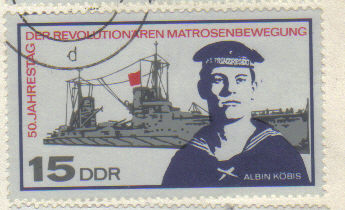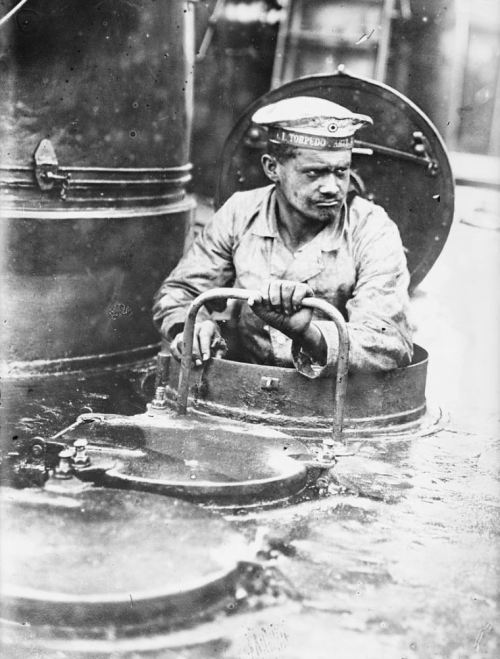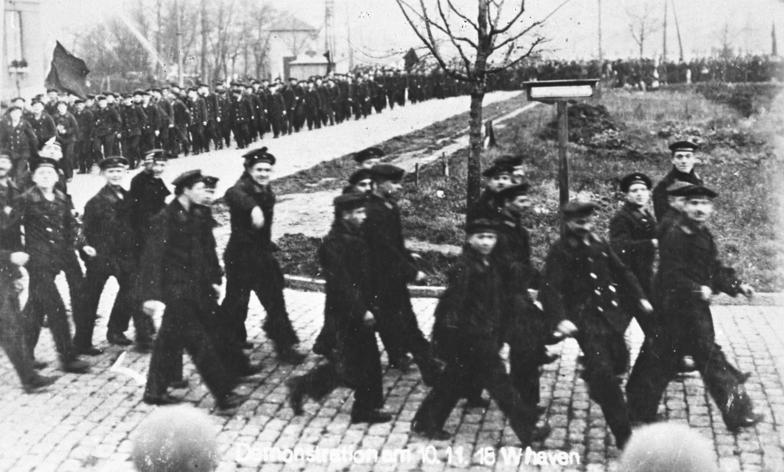Navy is Cauldron of Dissent.
Mutineers Jailed and Shot.
Special to The Great War Project.
(20 August) Fighting is furious once again at the Belgian town
of Ypres on the Western Front a century ago, provoking disillusion in the German ranks.
German sailor in turret of torpedo boat.
It’s one of the first moments that this dissent breaks out into public view.
In early August, reports historian Martin Gilbert, more than 5000 German soldiers were taken prisoner. “For the Kaiser and his commanders, however, the danger was not only on the Western Front. When British troops took up their new positions at Ypres, trouble broke out aboard the German battleship Prinzregent Luitpold at the port of Wilhelmshaven.”
At that point a stoker, Albin Kobis, led four hundred sailors into the town and addressed them with the call: Down with the war! We no longer want to fight this war!

East German postage stamp honoring Albin Kobis
Kobis and the sailors were persuaded to return to their ship.
Much of the anger was caused by widespread hunger, in both the military and civilian populations. The British blockade of Germany had a deep affect. “The shortages were catastrophic,” writes historian Eugene Rogan. “The majority of Germans may still not have been willing to end the war at any price, but morale was very fragile and the atmosphere fractious.”
There were food shortages as well within the military, especially in the navy. “The rations of battleship crews were miserable,” reports historian Rogan, “while their superiors still ate well.”
“The summer of 1917 had seen repeated strikes on several battleships as sailors tested the limits of authority and tried, mostly successfully, to assert their rights.”
“The home district commanders warned that the longing for peace is spread throughout all classes of the population.”
This follows a wave of strikes earlier in the year in which some 300,000 workers participated.” The spark that ignited the strikes? Reduction of the very inadequate bread ration.
According to historian Gilbert, much of the subversion in the military was focused on the navy. The naval command viewed any political activism as subversion and revolutionary insurrection.

German field bakery near Ypres, Belgium.
And that wasn’t far from the truth. Kobis and his fellow plotters had hoped to “spark a strike demanding peace across the battle fleet.” Some 5,000 sailors signed a petition.
Gilbert reports there was no violence. “but in the aftermath, courts martial handed down ten death sentences, two of which were carried out.
As for Kobis, he and the sailors that followed him were labeled as “bad political attitudes” and were sent to shore stations. Seventy-five of them were jailed.
Kobis, according to Gilbert, “was one of those sentenced to death and was shot by an army firing squad.
Before his execution, he wrote to his parents, ‘I die with a curse on the German-militarist state.”
Mutinous German sailors.
Kobis’s wasn’t the only such rebellion. In another, a sailor who was sentenced to death, had his sentence commuted to fifteen years in prison. According to Gilbert, he told the court “nobody wants a revolution; we just wanted to be treated more like human beings.”



The German Sailor In the photograph appears to have Coal Dust on his face, hands and uniform suggesting that he was most likely a Watertender (stoker) a sailor used to keep the boilers funcationing. His hat rim marked with the visable word TORPEDO most likely his ships name.